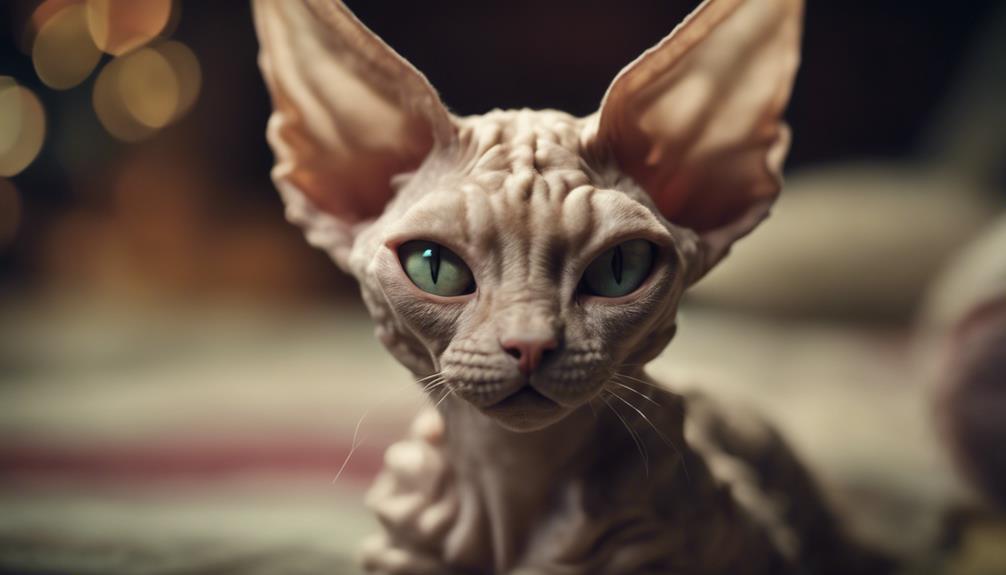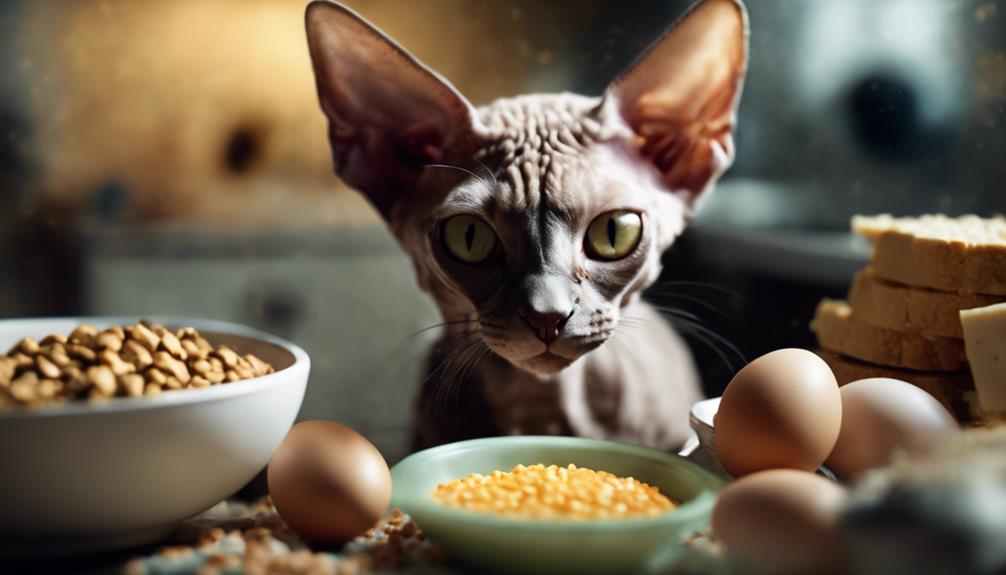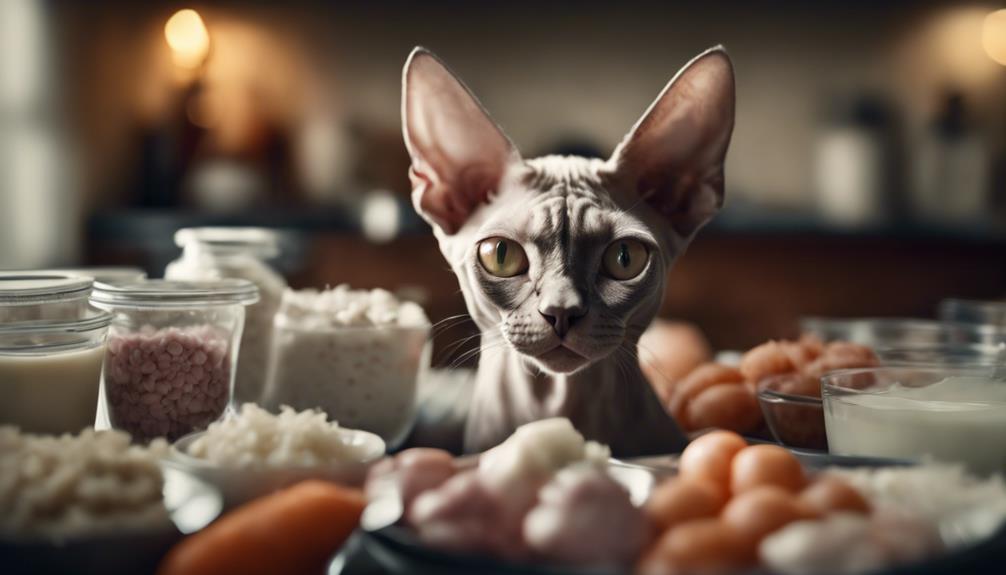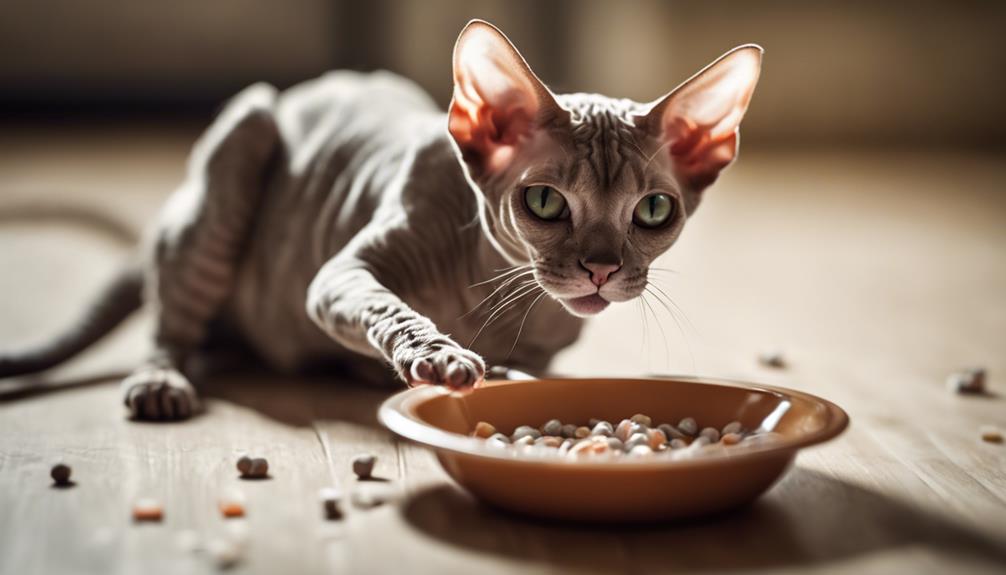As the saying goes, ‘Curiosity killed the cat,’ but when it comes to the Devon Rex breed, curiosity only makes them more endearing. Unveiling the ten best facts about Devon Rex cats will reveal their fascinating origins, unique genetic mutations, and the challenges faced in preserving their distinct characteristics.
From their playful antics to their preference for perches, each aspect of this breed’s existence paints a picture of a truly captivating feline companion.
Key Takeaways
- Originated in 1960 near a tin mine in Devonshire, England by Beryl Cox.
- Unique curly coat from genetic mutation maintained through selective breeding.
- Highly intelligent, playful, and trainable breed ideal for active households.
- Conservation efforts through strict breeding programs ensure breed’s distinct traits and health.
Origins of the Devon Rex
The Devon Rex breed traces its origins back to 1960 in Devonshire, England, near an old tin mine where the first Devon Rex cat was discovered by Beryl Cox and affectionately named Kirlee. Beryl Cox stumbled upon this unique, curly-coated feline, marking the beginning of a distinctive breed.
Kirlee became the cornerstone for the development of the Devon Rex lineage, showcasing the breed’s defining traits from the outset. With its playful demeanor and striking appearance, Kirlee captured the hearts of many and sparked interest in this newfound breed.
Beryl Cox’s chance encounter with Kirlee set the stage for the future of the Devon Rex breed, laying the foundation for a lineage that continues to enchant cat lovers worldwide.
Early Development of the Breed
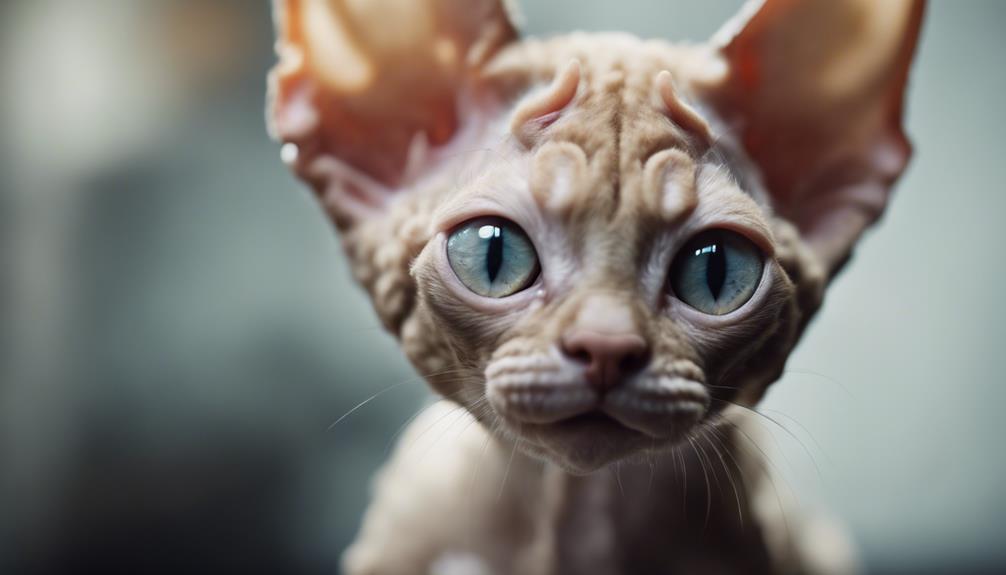
During the early stages of the breed’s development, breeders experimented with various mating strategies to enhance the unique curly coat of the Devon Rex cats. The first Devon Rex cat, Kirlee, stood out with its distinct curly coat, sparking interest in breeding for this trait.
Attempts to crossbreed with the Cornish Rex initially failed to produce the desired curly-coated kittens, leading to a focus on the specific coat genetics of the Devon Rex. This emphasis on genetic traits eventually led to the recognition of the Devon Rex as a separate breed from the Cornish Rex.
The introduction of the Devon Rex to the United States in 1968 quickly captured attention for its extraordinary appearance and lively personality.
| Early Development of Devon Rex | |
|---|---|
| Location | England |
| Key Cat | Kirlee |
| Distinct Coat Feature | Curly |
| Recognition Year | 1968 |
Influence of Genetic Mutations

In exploring the Influence of Genetic Mutations on the Devon Rex breed, one discovers the fascinating origins of the unique curly coat that distinguishes these cats. Genetic mutations play a crucial role in shaping the appearance of the Devon Rex, specifically influencing the structure of their hair follicles.
These mutations lead to the development of the breed’s wavy and soft coat, setting them apart from other rex breeds like the Cornish Rex. The curly coat of the Devon Rex is a product of a spontaneous genetic mutation that occurred early in the breed’s history.
These genetic variations are inherited and carefully selected through breeding to preserve the breed’s distinct appearance, making the Devon Rex a truly unique and captivating feline companion.
Recognition by Cat Associations

Being recognized by cat associations in the 1970s marked a significant milestone for the Devon Rex breed, solidifying its status and popularity within the feline community.
This recognition ensured that Devon Rex cats met specific breed standards and criteria, providing breeders and enthusiasts with guidelines for maintaining the breed’s unique characteristics.
The acknowledgment by major cat associations was pivotal in establishing the Devon Rex as a distinct and valued breed within the cat fancy world.
- Recognition by cat associations in the 1970s elevated the status of the Devon Rex breed.
- Breed standards set by these associations helped maintain the unique qualities of Devon Rex cats.
- The recognition opened doors for Devon Rex cats to participate in official competitions and events.
Breeding Programs and Standards
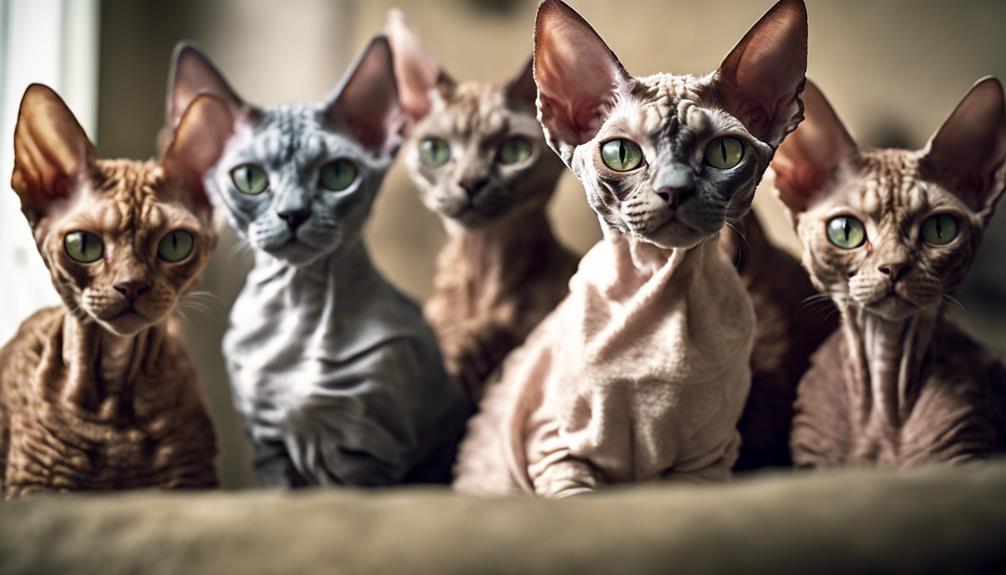
Recognition by cat associations in the 1970s paved the way for stringent breeding programs and standards that focus on preserving the unique characteristics and coat texture of the Devon Rex breed.
Devon Rex breeding programs are meticulous in maintaining the breed’s distinct curly-coated appearance and specific physical characteristics. These programs emphasize factors like coat color, pattern, texture, and body structure in selecting breeding pairs. Breeders adhere to strict guidelines to ensure the preservation of the Devon Rex’s unique qualities.
Evolution of Physical Characteristics
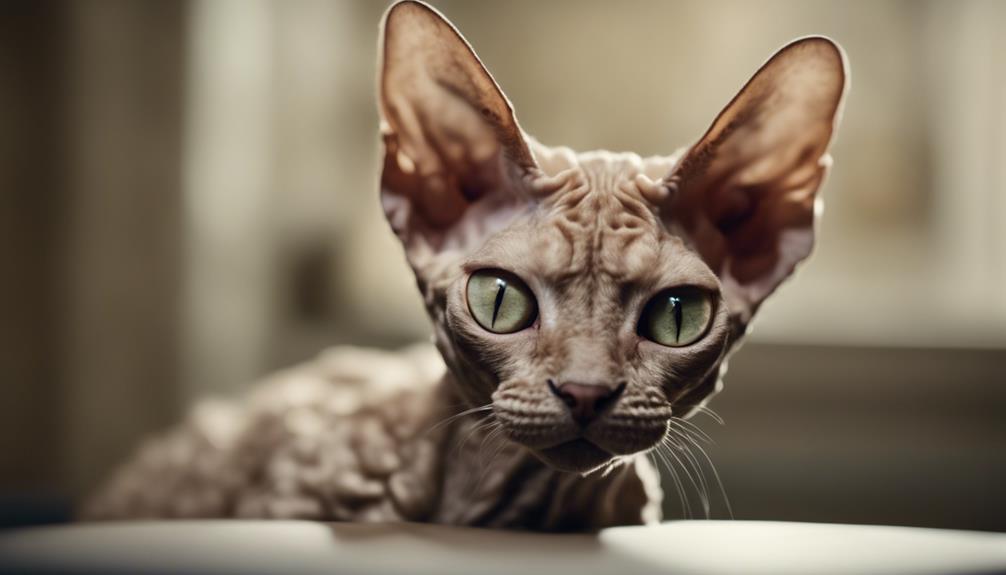
I’ll begin by exploring the genetic mutations that have influenced the distinctive physical characteristics of Devon Rex cats, such as their unique coat textures and large ears.
Understanding the evolutionary journey of these felines sheds light on how their appearance has been shaped over time.
The development of these traits showcases the intricate nature of genetic variations within the Devon Rex breed.
Genetic Mutations in Appearance
Exploring the genetic mutations that have influenced the physical characteristics of the Devon Rex breed reveals the fascinating evolution of their unique appearance. These mutations have resulted in distinctive features such as their curly coats and elf-like appearance. Here are three key points to consider:
- Genetic mutations affect the structure of the hair follicles, giving the Devon Rex their wavy and soft coat texture.
- Specific genetic variations are responsible for the breed’s appearance, setting them apart from other cat breeds.
- Through selective breeding practices, breeders have preserved and even enhanced these genetic mutations to maintain the characteristic look of the Devon Rex.
Distinctive Coat and Ears
With their distinctive short, wavy coat and elf-like ears, the evolution of physical characteristics in Devon Rex cats showcases a blend of unique traits that set them apart from other breeds.
The Devon Rex breed is recognized for its soft and curly coat that covers the entire body, including the head, ears, neck, paws, chest, and abdomen.
These cats sport large, elf-like ears that add to their captivating appearance, making them easily distinguishable. Their fine, wavy coat comes in various colors and patterns, such as black, blue, chocolate, cinnamon, and tortoiseshell.
This breed’s appearance, with high cheekbones and expressive eyes, is a result of the evolution of their physical features, highlighting their distinct charm and appeal.
| Trait | Description |
|---|---|
| Coat Texture | Short, wavy, and curly, covering the entire body including head, ears, neck, paws, chest, abdomen |
| Ear Size | Large and elf-like, contributing to their unique and striking appearance |
| Coat Colors | Available in various colors like black, blue, chocolate, cinnamon, tortoiseshell, and more |
Popularity and Spread Globally

The Devon Rex breed’s rapid rise to popularity and global presence since its introduction in the United States in 1968 underscores its widespread appeal and charm. This unique cat breed has captured the hearts of people worldwide due to its distinctive appearance and playful nature.
Here are three key points highlighting the popularity and global spread of the Devon Rex:
- Devon Rex cats gained initial popularity in the United States in 1968.
- The breed’s unique traits quickly led to its global recognition and appreciation.
- Devon Rex cats continue to grow in popularity as more individuals discover and admire their quirky and endearing characteristics.
Impact of Crossbreeding
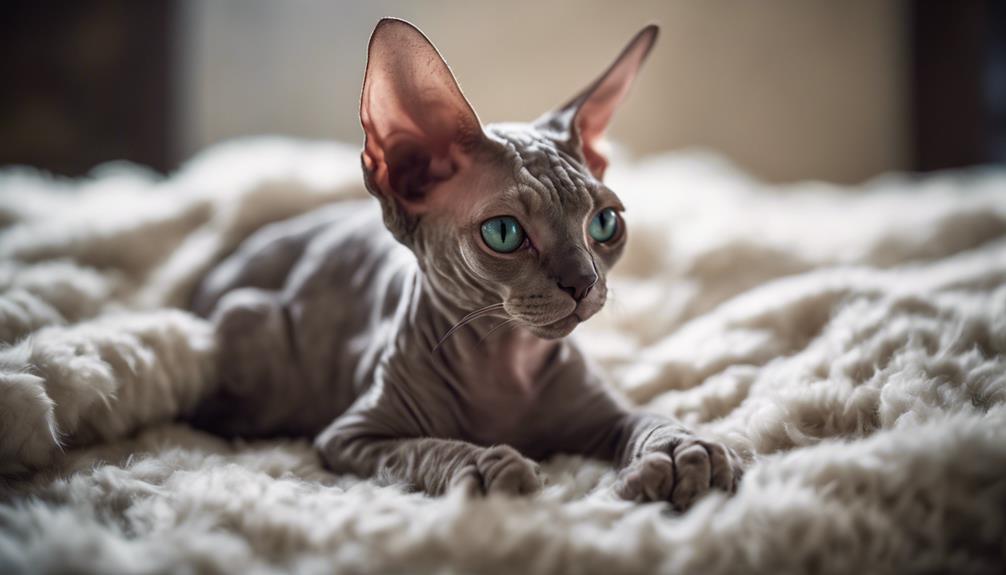
Crossbreeding Devon Rex cats introduces new traits and characteristics from other cat breeds while potentially widening the gene pool and reducing the risk of inherited health issues.
When carefully planned, this practice can lead to unique coat patterns or colors not typically found in purebred Devon Rex cats. Breeders may strategically crossbreed to enhance certain desirable traits within the Devon Rex breed.
It is crucial to maintain the integrity of the breed standard through thoughtful selection processes. By incorporating genetic diversity, crossbreeding plays a vital role in promoting a healthier population of Devon Rex cats.
| Benefits of Crossbreeding Devon Rex Cats |
|---|
| Introduces new traits and characteristics |
| Widens the gene pool |
| Reduces the risk of inherited health issues |
| Leads to unique coat patterns/colors |
| Enhances desirable traits |
Preservation Efforts and Challenges
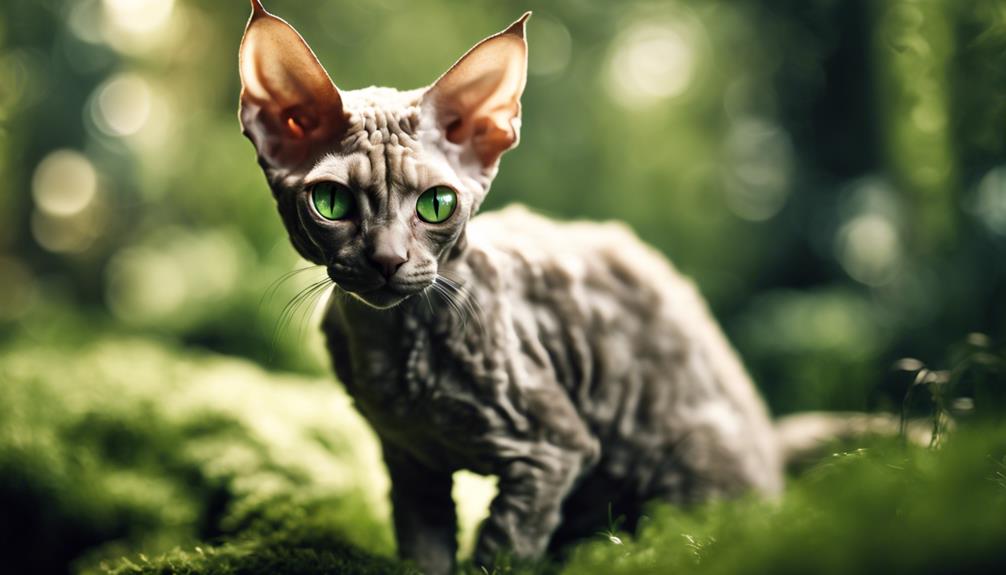
Preserving the unique curly coat texture of the Devon Rex breed requires meticulous attention to breeding practices to ensure its distinctive characteristics endure. Efforts to preserve the Devon Rex breed involve collaboration among breeders, veterinarians, and cat associations to promote responsible breeding.
Challenges in maintaining this breed include avoiding health problems associated with inbreeding and ensuring genetic diversity. To safeguard the Devon Rex population’s well-being, breeders must work diligently to uphold breed standards while addressing potential genetic health concerns.
Conservation efforts also entail monitoring and swiftly addressing any emerging health issues to sustain the breed’s vitality. Through these combined efforts, the future of the Devon Rex breed can be secured for generations to come.
Future Prospects for the Devon Rex

Amidst a growing fascination with unique feline companions, the future prospects for the Devon Rex breed appear increasingly promising.
Devon Rex cats need attentive care to maintain their overall health, including regular grooming to manage their unique coat texture. Being a highly intelligent cat breed, mental stimulation through interactive play and training is essential for their well-being.
When it comes to cat health, the Devon Rex breed generally enjoys good overall health, with a lifespan ranging from 9-15 years.
As cat enthusiasts continue to appreciate their playful personality and trainability, breeders are dedicated to preserving the distinct characteristics that make the Devon Rex a beloved and sought-after companion for active households.
Frequently Asked Questions
What Is Special About a Devon Rex Cat?
I love Devon Rex cats for their playful antics, unique appearance, energetic personality, and affectionate nature. Their elf-like features, wavy coat, and mischievous charm set them apart. They are a delightful addition to any family.
Are Devon Rex Cats Cuddly?
Yes, Devon Rex cats are incredibly cuddly. They seek out physical contact and enjoy snuggling on laps or shoulders. Their affectionate nature fosters strong bonding experiences with their owners. Plus, they’re playful and sociable, making them wonderful companions.
Are Devon Rex Cats High Maintenance?
High maintenance? Not at all! With minimal grooming needs, daily exercise requirements, some training tips, and cost considerations for quality care, Devon Rex cats are surprisingly easy to care for and provide endless joy.
What Health Issues Do Devon Rex Cats Have?
Common health issues in Devon Rex cats include hypertrophic cardiomyopathy, hip dysplasia, luxating patella, congenital myasthenic syndrome, and hereditary baldness. Regular screenings are essential for early detection. They require moderate grooming, love play, have a friendly temperament, and need regular exercise.

